At the base of any bed is a foundation that supports the mattress above. It’s critically important, but how do you know what mattress foundation is right for you? Wood stats, box springs, metal foundations, platforms?
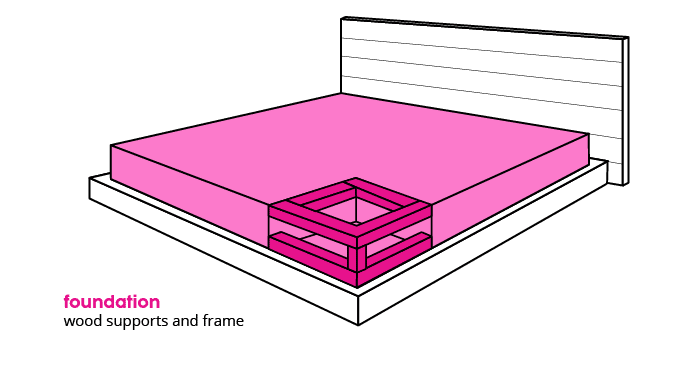
In This Guide | What Is A Mattress Foundation | Why You Need a Mattress Foundation | Types of Mattress Foundations | How To Choose the Right Foundation? | FAQs
What is a Mattress Foundation
A mattress foundation is a part of any “bed” that provides support beneath the mattress itself. It can take the form of many designs and be made from a wide range of materials and sold at a wide range of price points.
Virtually all mattresses require a foundation…sometimes that foundation is built into a frame, and sometimes it’s a separate box, slats, or platform, but either approach provides support for mattresses.
Why You Need A Mattress Foundation
What would happen if you skipped the mattress foundation entirely? Without a foundation, there would be a host of problems to follow.
Some of the most important roles of the mattress foundation include:
- Improved longevity of a mattress: Like most things, if you take care of them, they last longer. A mattress that is well-supported by a high-performance foundation is less prone to sagging and can do a better job of providing support.
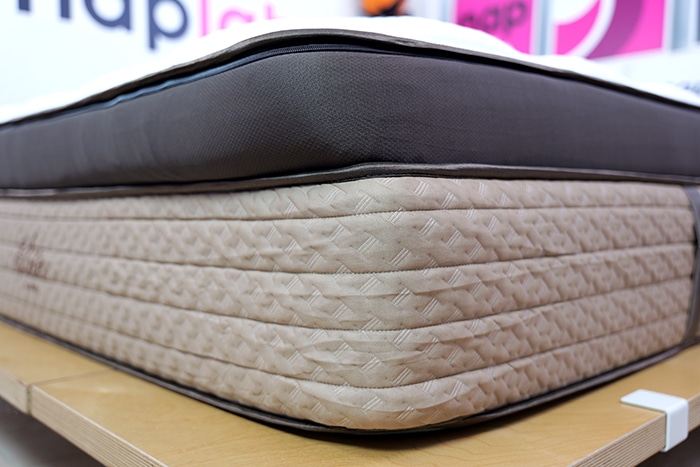
- Raised bed height: A mattress on the floor may be supported by the floor, but it lacks the comfort of being raised to a reasonable height that makes it easy to get in and out of bed. For the easiest height to get in and out of bed, you’ll want a foundation that raises your mattress to be around 25″ off the ground (right around knee height or slightly higher). In addition, placing the mattress directly on the floor can create hygiene problems, as well as moisture and breathability issues.

- Warranty protection: Many mattress manufacturers will not honor the terms of their warranty if you cannot prove that the mattress was used on a supportive foundation. To protect your mattress for the longest time possible, opt for a supportive mattress foundation that abides by any written requirements in the warranty.

Quality is also hugely important here. Choosing a low-quality foundation made of inexpensive materials will save you money in the short term, but it also often results in a mattress that is not as well supported, sags earlier, and doesn’t last as long.
A high-quality foundation can provide better mattress longevity and performance, ultimately extending the life and sleeping performance of your mattress.
Types of Mattress Foundations
There are many different types of mattress foundations and the mattress industry doesn’t always make things super clear.
Companies call different foundations by different names so let’s break down the basics.
There are two main approaches that a foundation can take—all-in-one or separate pieces.
All-In-One Foundation
& Bed Frame
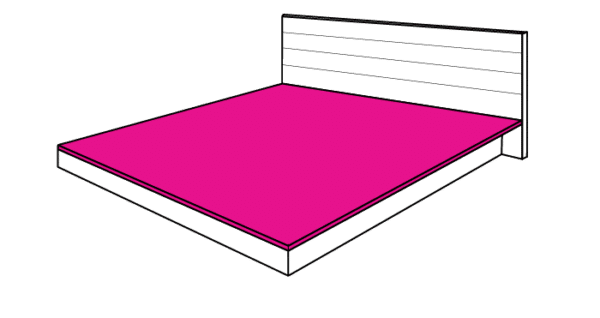
Bed Frame & Foundation
Separate

All-In-One Foundations
When a foundation and frame are an “all-in-one”, a single piece of furniture provides the design aesthetic as well as the foundational mattress support.
In the examples below, you can see that these all-in-one approaches can have a range of design aesthetics but each will have a supportive foundation.
Floyd Platform Bed
All-In-One

Winkbed Foundation
All-In-One

In the example on the left, the foundation is a platform bed. In the example to the right, the foundation is a box foundation style that is seamlessly integrated with a support frame.
Separates: Bed Frame + Foundation
When the bed frame and foundation are separate, they are designed to work in tandem. A bed frame cannot be used without a foundation and vice versa—a foundation without a frame would be pretty useless as well.
In most cases, the frame will have a void in the middle and lack a support system. The foundation then either drops into the frame or sits directly on top of the frame for a cohesive look.
Here is an example of two separate pieces that could work together to support a mattress.
Metal Bed Frame
Frame Separate
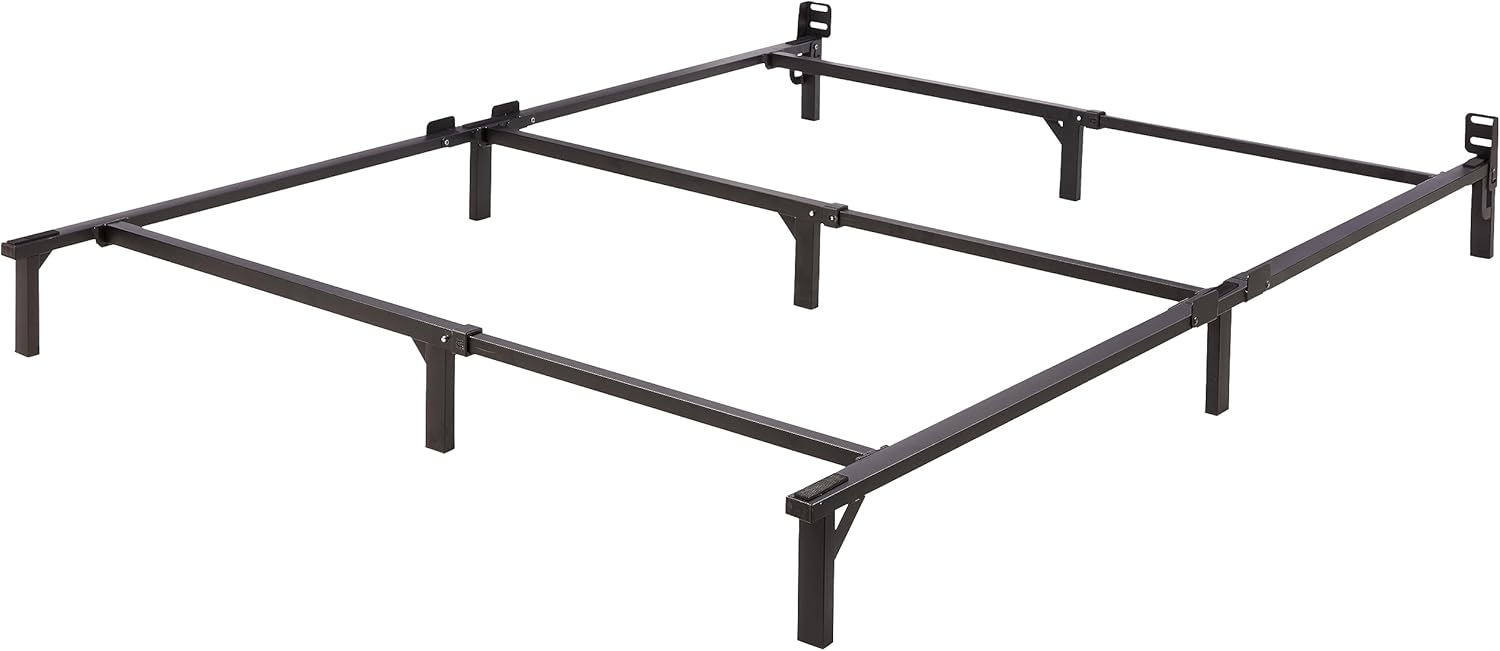
Box Foundation
Foundation Separate

Metal bed frames may or may not have a central beam that runs along the middle of the mattress for support. A central beam provides critical support to the foundation above and is a good indicator of a high-quality, more supportive bed frame.
A more robust central beam helps prevent sagging in the center of the mattress, which can be very common in Queen, King, and larger mattress sizes that don’t have the support beam.
6 Popular Mattress Foundation Types
In the mattress market, there are dozens of different combinations you may find for bed frames, foundations, etc.
Different designs or materials used can sometimes make it hard to identify an exact classification for each foundation style. That being said, we’ve broken down the selection into six popular foundations.
This list of 6 foundations represents the most popular foundation types:
- Platform Base
- Adjustable Bed Base
- Box Springs
- Box Foundations
- Bed Slats
- Bunkie Boards
Below we’ll go into a bit more detail for each foundation type.
1. Platform Base
Platform bases are popular due largely to their simple design and modern look. Mattresses on platform bases tend to sit lower to the ground and are supported by a solid base. This base can also sometimes be perforated for increased airflow.
Many platform beds are made of wood, but that’s not to say that other materials don’t exist. Platforms of metal, plastic, composite, and other material types also are common.

Note: A low bed with wooden slats is not a true platform bed, although many products call them platforms anyway. A true platform bed will always have a solid base.
Platform
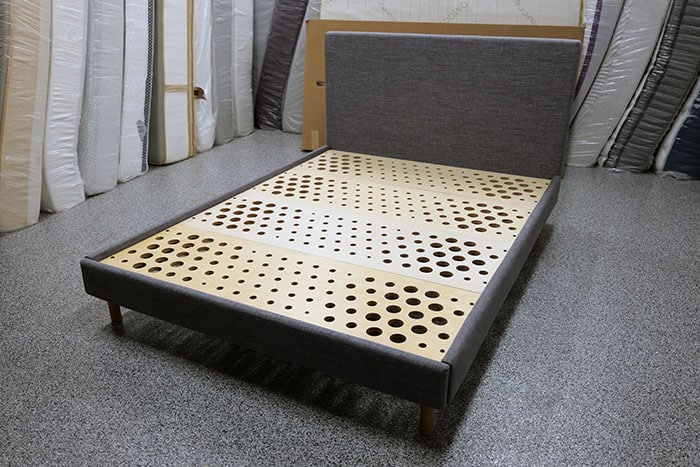
Sleeping Duck Indestruct Bed
The Sleeping Duck Indestruct Bed is a platform bed that has holes cut into the surface for breathability and airflow (without sacrificing support). A strong metal base supports the platform. The unit comes with wooden sides or fabric and with or without the headboard. This bed is insanely durable and designed to last for decades.
2. Adjustable Bed Base
An adjustable bed base has a pseudo-platform, usually metal with an upholstered finish. However, there will be small gaps between the adjustable sections.

Using a remote or other dial on the bed itself, sleepers can adjust the position of the bed platform.

You can raise or lower the head or foot of the mattress and adjust for various activities or uses.
Adjustable

Saatva Adjustable Base
The Saatva Adjustable Base offers a range of customizations to get your mattress in the ideal position. You can elevate the head or foot of the mattress with the touch of a wireless remote. There is a massage feature, memory presets, underbed lighting, and USB ports for charging other devices.
3. Box Springs
Many more traditional innerspring-style mattresses require a box spring. A true box spring will always have actual metal springs on the interior of the box, supported by a rigid support frame.

The coils help to support the mattress above and the wooden frame gives the mattress structure.
4. Box Foundations
Modern “box springs” (I put this in quotes because they aren’t really box springs, as they don’t contain springs) lack coils entirely, instead being made of metal or wood frames with rigid supports. This type of foundation is often referred to as a foundation or box foundation. Some brands will still call these “box springs”, even though they don’t contain springs.

These types of foundations use rigid materials, often wood, metal, plastic, or composite slats / bars to create support for the mattress.
Box foundations can come in varying heights, ranging from 4-12″ typically. Choosing the right height is based more on personal preference than anything else.
Box Foundation
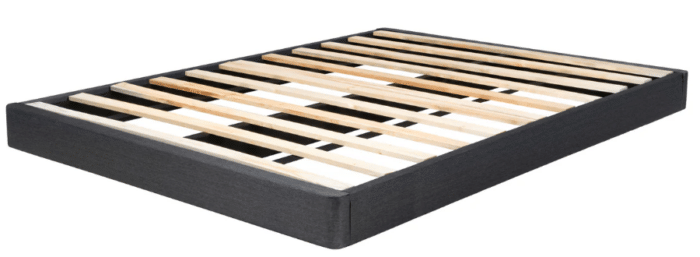
Bear Foundation
The Bear Foundation has a rigid box frame with upholstered sides. Wood slats roll out across the top and inset flush against the top of the foundation. It is available in two heights, 5.5″ or 7.5″. There is no headboard or footboard so this box foundation can be used with a separate bed frame or wall-mounted headboard.
A low-profile foundation can provide support to the mattress without being excessively tall. In the same way, a thicker foundation can help add height, which is especially beneficial if your bed frame is low to the ground.
5. Bed Slats
Bed slats are commonly seen in “all-in-one” foundation / bed systems, where the slats are integrated into the frame itself. Slat systems are typically wood or metal, but can be other materials also.
- Metal slats typically use metal hardware to attach to a metal frame. These are commonly seen in all-in-one foundations.
- Wood slats typically roll out and are placed onto the frame during the assembly process. Some slat units arrive separated and each slat slots into place.
Wooden Slats
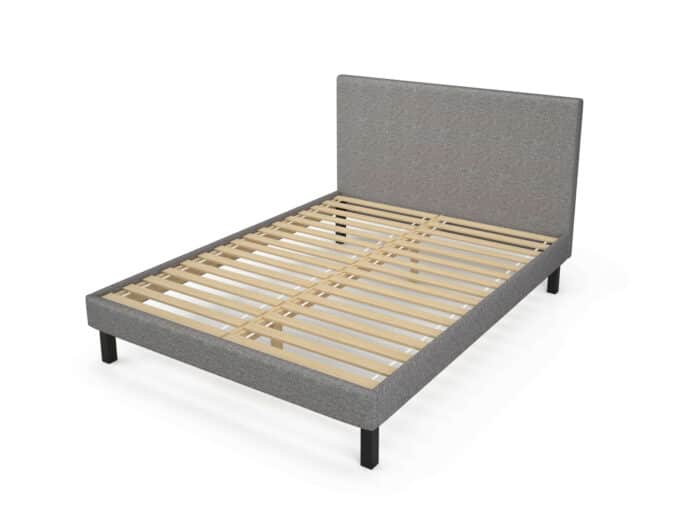
Amerisleep Bed
Amerisleep technically calls this a “Platform Bed Frame”, but because it uses a system of wooden slats (and not a solid flat platform), we refer to this as a slat system. This unit includes a frame, headboard, and upholstered side walls for under $500 (for a queen).
Whether you are looking at metal or wood slats, the important thing to remember is that not all slats are the same—there are good slat systems and bad slat systems.
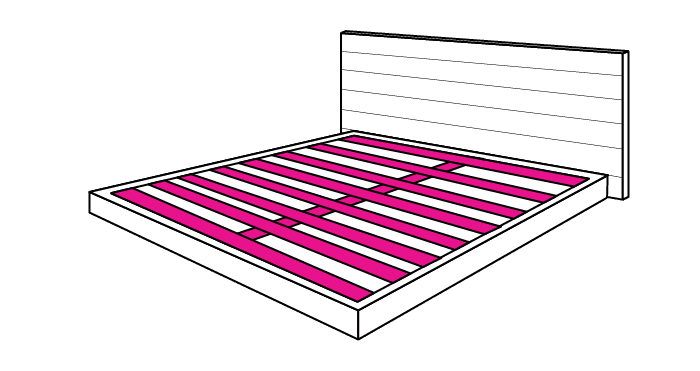
A good slat system will use high-quality materials and the slats that are designed for better performance. There is not an exact gauge here, but pricing is a relatively easy indicator of quality.
A slat foundation that is under $150 likely uses low-quality materials and may not be supportive enough for all mattresses or heavier-weighted sleepers.
With high-quality wood and slats placed close enough together, a slat foundation can be a supportive and cost-effective way to support a mattress.
Pseudo Platform
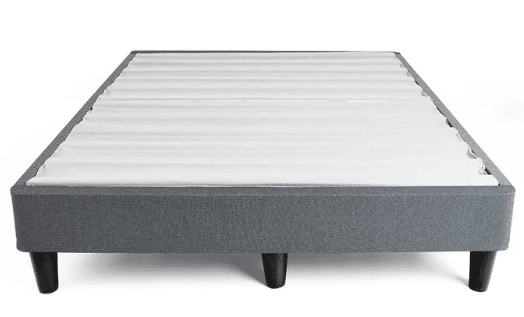
Winkbed Platform Foundation
The Winkbed Platform Bed has tapered legs, unholstered sides, a strong central beam support, and slats for support. While I typically like to see a solid platform, the Winkbed uses wooden slats with a fabric cover. There is no headboard or footboard with the Winkbed Platform, giving the bed a simple, modern look.
Ideally, you want to look for slat frames with the following characteristics:
- Slats that are close together – no more than 3.0″ apart
- Slats that are rigid – IE, avoid flexed or “bowed” slats
- Slats that are thick – at least 5/8″ thick
- Slats that are wide – ideally 3.0″ or wider
- Slats that have a strong central beam running down the center of the unit, especially for Queen, King, and larger sizes
If you have an existing bed frame that doesn’t use slats, but you’d like you include it, you may want to consider a roll-out slat system or slats that attach to a low-profile metal frame.
Roll-Out Slats
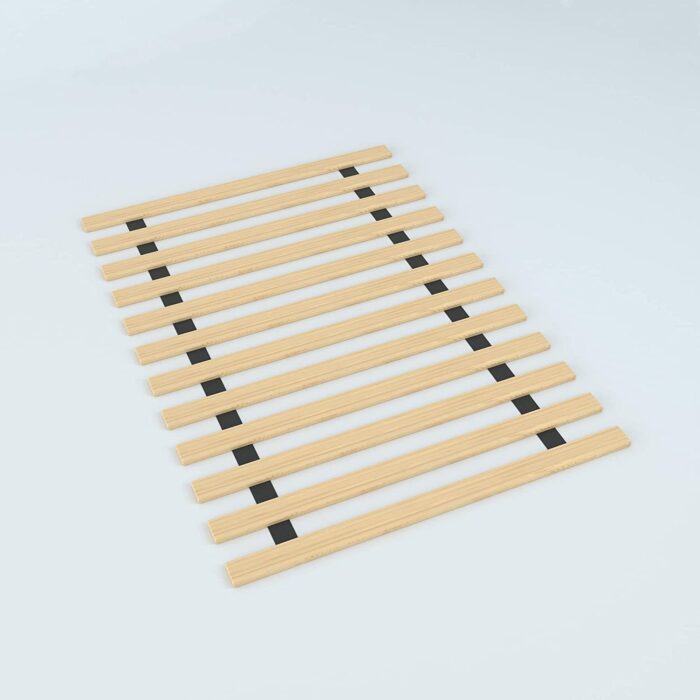
Slats With Metal Frame

Either of these approaches provides support while still working with your existing frame.
6. Bunkie Boards
Bunkie boards are basically thin platforms that work with existing bed frames that lack foundational support. A bunkie board is commonly wood, but can also be made of metal, plastic, or composite material.
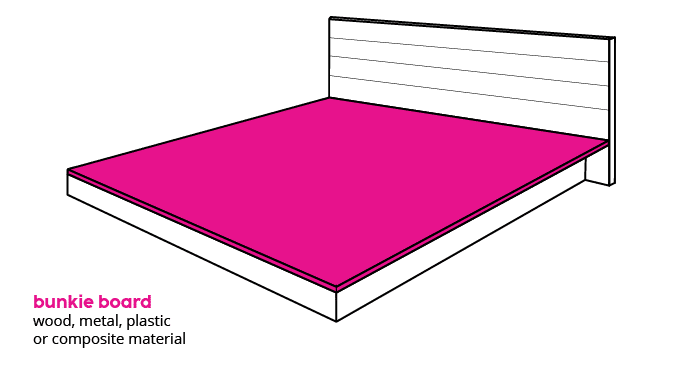
For easier shipping, bunkie boards are oftentimes divided into quarters or thirds and fold out onto the bed frame.
Bunkie boards are cost-efficient and easy to install. They can also easily be moved and used with multiple types of setups.
Bunkie Board
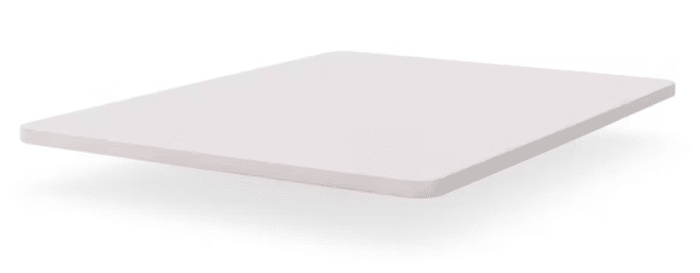
Saatva Bunkie Board
The Saatva Foundation is a supportive foundation available in three different styles—2″ bunkie board, 4.75″ low-profile foundation, or an 8.75″ foundation. It is supportive and the varying heights make it easy to get the exact support you need.
How To Choose the Right Foundation
A supportive foundation can reduce wear and tear, increase mattress life, and also reduce mattress sagging / body impressions. Therefore, it’s important to consider its design, size, and construction.
#1 – Choose the Right Size
Mattress foundations come in standard sizes. So, if you have a king-size mattress, you’ll choose a foundation in that particular size. See our guide to mattress sizes and bed dimensions for further insights.
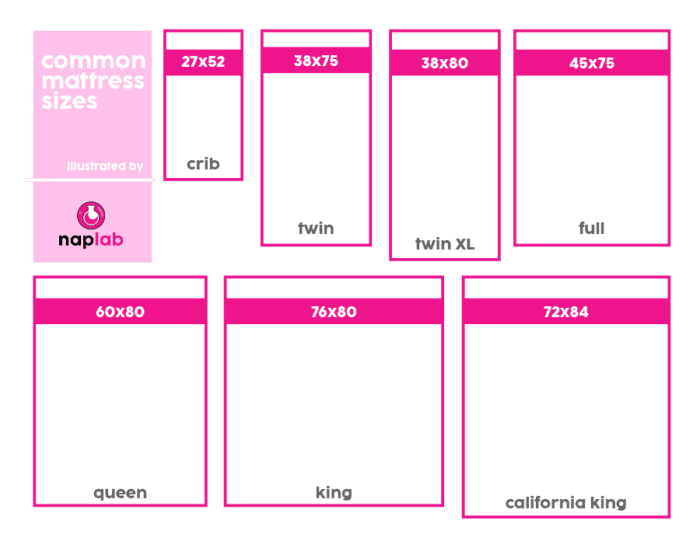
#2 – Verify It Will Work With Your Frame
Next, check your bed frame (if you have one). Some bed frames work only with box springs or box foundations, so make sure you can use yours with a mattress foundation.
#3 – Consider Your Specific Needs
Apart from that, take into account the following aspects:
- Your height: If you’re tall, a full-profile foundation (6-12″ thick) may be a better choice over a low-profile platform bed.
- Your body weight: A full or low-profile mattress foundation provides better support for heavier people than budget slatted foundations (which oftentimes have too wide of a span to provide adequate support). Also, note that some foundations have a weight limit.
- The size of your bedroom: Low-profile foundations or platform foundations can be a better choice for smaller rooms. They’re more compact than other options and may look better in a room with low ceilings.
- Portability: Choose a low-profile or slatted foundation if you tend to move homes a lot. These models are easier to transport due to their lighter weight.
- Visual appeal: Look for a mattress foundation that matches the overall theme of your bedroom. Consider its color, style, and materials.
- Care and maintenance: Upholstered mattress foundations require more maintenance than other styles. They’re not ideal for dorms and households with pets or small children.
- Your mattress warranty: Some mattress manufacturers require specific types of foundations. If you don’t comply, you risk losing the warranty.
- Type of mattress: Consider using a slatted foundation if your mattress traps heat. Slatted foundations often allow for better airflow than solid ones. Just make sure the slats are wider, rigid, and close together. Ideally, 3″ wide and no more than 3″ apart from each other.
- Your budget: Mattress foundations vary in price by thousands of dollars, depending on their size, materials, and other factors. Prices start at around $100 and can go up to $2,000 or higher. For most sleepers, a $300-$500 foundation is the sweet spot. Remember, a high-performance foundation will help your mattress perform better, extend its life, and reduce sagging in the mattress.
If you’re not sure what to choose, check with the mattress manufacturer to see what they recommend and what works with their warranty.
FAQs
A mattress foundation is a part of any “bed” that provides support beneath the mattress itself. All mattresses require a foundation, but sometimes the foundation support comes from an all-in-one bed frame.
No, in most cases, if you are using a foundation, you do not need a box spring. That being said, always check the mattress manufacturer’s warranty. Sometimes they will dictate approved foundations and if you aren’t using an approved foundation or box spring, they could void the warranty in the event of an issue arising.
In some cases yes. Placing the mattress directly on a bed frame is perfectly fine in places where the bed frame has a built-in acceptable foundation. This would include solid platform beds or frame systems that have integrated slats no more than 3.0″ apart.
A box spring is a type of foundation. Box springs have actual metal springs inside them and best suited to more traditional innerspring style mattresses. Foundations are also supportive “boxes”, but don’t contain metal springs. Instead, they contain rigid wood, metal, or other materials typically in slats or bars that provide support for the mattress. See our full Box Spring vs. Foundation guide for more.
While a solid floor technically provides enough support, it can cause a whole other host of issues including mold or bacteria growth, heat retention issues, voiding your mattress warranty, and even pressure relief problems (stemming from too much pushback).
Adding a bed skirt is the cheapest and easiest way to hide metal legs. For a modern look, you can also shop for “leg covers” which simply cover the metal legs in lieu of a different look (ie: wood, gold, composite, etc.).
Most mattresses require some type of supportive foundation. This support can come from an extra piece (like a box spring), the frame itself (like a platform bed), or a mattress foundation.
While there are some “gray areas”, here are some black-and-white scenarios to consider.
Your bed frame has no inner support structures. You need slats, a bunkie board, or a platform frame.
You have a panel bed, or your frame’s slats are more than 3.0″ apart. You need a bunkie board, new slats, or a box spring.
You want to sleep with your head or feet elevated. You need an adjustable base.


